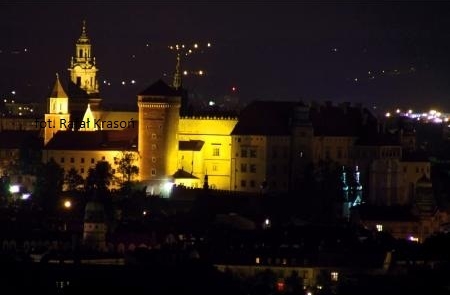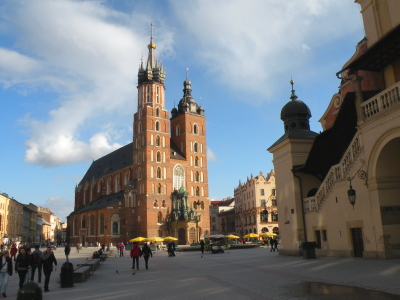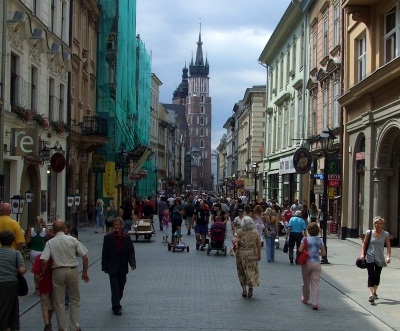 Krakow belongs to the oldest cities in Poland. First people lived on the hills and islands created by Vistula River. Such localization gave them security feeling, the river supplied them with food. Among the most inhabited islands belonged Wawel, Salwator, Bawół (today’s Kazimierz), Lasota (Krakus) and Tyniec. In these islands first churches were created and the most dense population lived.
Krakow belongs to the oldest cities in Poland. First people lived on the hills and islands created by Vistula River. Such localization gave them security feeling, the river supplied them with food. Among the most inhabited islands belonged Wawel, Salwator, Bawół (today’s Kazimierz), Lasota (Krakus) and Tyniec. In these islands first churches were created and the most dense population lived.
In 1000 the Wawel Hill got primary position, the king Bolesław the Strong built first cathedral in this place. Soon new town called Okół was created on the north side of the Wawel Hill. From this time Krakow has been divided into two zones: the Hill, as the living place of bishops, dukes and kings and Okół as the living place of townspeople.
In 13th century Poland has been occupied several times by the Tartars. Also Krakow suffered the invasion, however in 1257 the duke Bolesław the Chaste enlarged the city on the basis of Magdeburg Law, and in 1286 Leszek the Black surrounded it by the defensive walls. In second part of the 13th century large sectors of today’s old town have been created, together with the Main Market and net of streets leaving vertically or parallel the square.
 The reign of the king Casmir the Great (1333-1370) is a good period for Krakow. The king enlarges the city walls and creates two other towns: Kazimierz (build from the ground) and Florence (by giving privilages). He also builds several churches (Saint Katarina's church, Corpus Christi church), some of them exist until now. The king Casimir the Great established first Polish Academy (today Jagiellonian University), which was the second after Prague university in this part of Europe. The king Casimir dies in 1370 but the prosperity does not leave Krakow.
The reign of the king Casmir the Great (1333-1370) is a good period for Krakow. The king enlarges the city walls and creates two other towns: Kazimierz (build from the ground) and Florence (by giving privilages). He also builds several churches (Saint Katarina's church, Corpus Christi church), some of them exist until now. The king Casimir the Great established first Polish Academy (today Jagiellonian University), which was the second after Prague university in this part of Europe. The king Casimir dies in 1370 but the prosperity does not leave Krakow.
After short period of the reign of Hungarian king Ludwig, new Jagiellonian dynasty comes. The dynasty stays in charge for 186 years (1386-1572), bringing real power to the country. 15th century Krakow was the capital of one of the strongest empire in the world. Visual effect of that period are late gothic churches, Collegium Maius of the Jagiellonian University, Royal castle of Wawel, the Cloth Hall, and several chapels adorning other temples of Krakow.
In 1572 the last king of Jagiellonian dynasty dies and the problem of crone succession comes. After short period of the reign of Henry Walezy and Stefan Bathory, Swedish duke but with Jagiellonian blood gets Polish throne. He opens short Vasa dynasty lasting 72 years. Choosing Vasa family involved Poland with bloody wars with Sweden, besides Poland had unstable situation with Russia and Turkey. Several wars weaked Poland and brought to loosing control with its internal and external policy. Krakow lost its position as the capital, in 1596 the king changes it into Warsaw, however, still the Cathedral of Wawel became the coronation place of the kings. Negative effects come in the end of 18th century. In 1772 Poland loses some of its territory, Krakow becomes the border town, on the other bank of the Vistula river, Austrians build the city of Podgórze in the purpose to compete with royal Krakow.
 Soon after Poland loses its independence and Krakow becomes a part of Austria (from 1849 Austria-Hungary Empire). For the occupants Krakow becomes the defensive town, they afraid attack of Russians from the north (the border was just 15 km from Krakow. Austria-Hungary emperor Francisco-Joseph decided to fortify Krakow. This decision stopped developing the city for the next sixty years.
Soon after Poland loses its independence and Krakow becomes a part of Austria (from 1849 Austria-Hungary Empire). For the occupants Krakow becomes the defensive town, they afraid attack of Russians from the north (the border was just 15 km from Krakow. Austria-Hungary emperor Francisco-Joseph decided to fortify Krakow. This decision stopped developing the city for the next sixty years.
Fast development came after 1910 when, during the presidency of Juliusz Leo, the territory was enlarged, Krakow included nearby villages.
II world war was relatively peaceful concerning monuments of Krakow. In comparison to other cities in Poland, some of them destroyed in 90%, Krakow didn’t lose much of its sights. Germans perceived Krakow as German town, except of Jewish sights, they preserved monuments of Krakow.
The buildings in major part survived, but not the people. Krakow, just before the war had about 65 thousand Jewish inhabitants. Most of them were killed in ghettos and concentration camps, some escaped from Europe.
18 of January Krakow got freedom but soon communism started. Nearby Krakow new town Nowa Huta was erected. The new city had to compete with Krakow, built from the ground had to be perfect settlement. In fact it never became independent city, soon it was included to Krakow.
Contemporary Krakow has 760 thousand inhabitants and is second big city in Poland.
Literature in English:
• Bohdanowicz Halina, I zawsze Kraków, Warszawa 1980, translation by Mirosław Luboń 'Cracow for ever' p. 201-204
• Miezian Maciej, Krakow's Old Town. Retracing Kings, Artists and Alchemists, Kraków 2004
• Rożek Michał, Kraków. World Cultural Heritage, Krajowa Agencja Wydawnicza, Kraków 1988, p. 10-16, translation by Roman Czarny.













